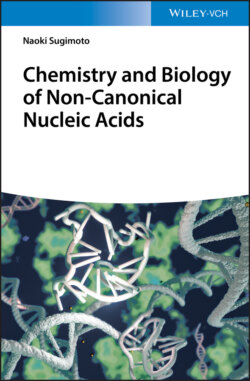Читать книгу Chemistry and Biology of Non-canonical Nucleic Acids - Naoki Sugimoto - Страница 45
3.2 Factors Influencing Stabilities of the Canonical Duplexes 3.2.1 Hydrogen Bond Formations
ОглавлениеThree factors are mainly responsible for the stability for the canonical structure of duplex: base pairing between complementary strands, stacking between adjacent bases, and conformational entropy of the backbone.
Electronegative O and N atoms with free lone pairs are potential hydrogen bond acceptors. Hydrogen atoms that have strong partial positive charge and are potential hydrogen bond donors bind to electronegative atoms such as O and N. Many of the oxygen, nitrogen, and hydrogen atoms in the nitrogenous bases are very effective hydrogen bond donors and acceptors, as illustrated in Figure 3.1. Adenine (A) and thymine (T) form base pairs via hydrogen bond donors and acceptors, and the A-T base pair has two hydrogen bonds between the bases. Cytosine (C) and guanine (G) similarly form base pairs with three hydrogen bonds (Figure 3.2a). The values of free energy change at 37 °C (−Δ) due to a hydrogen bond formation during duplex formation are 0.4–1.8 kcal mol−1. Moreover, the nucleic acids have polar groups that form a complex network of hydrogen bonds with the surrounding water molecules (see Chapter 4). Some of these bonds must be broken during duplex formation as the inter-base hydrogen bonds are formed. The hydrogen bonds due to hydration depending on the structure also affect nucleic acid stability.
Figure 3.1 Potential hydrogen bonding sites in bases of the nucleosides. Hydrogen bonding donor sites are labeled with red arrows, and hydrogen bonding accepter sites are labeled with blue arrows.
Figure 3.2 (a) Hydrogen bond formation in base pairs in a DNA duplex. The hydrogen bonds are shown in dashed lines. (b) Duplex structures of DNAs are depicted in tube and ball-and-stick models, respectively. Stacking interactions are shown in arrows.
